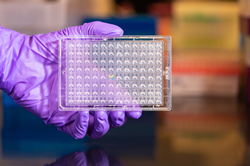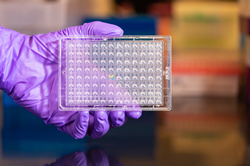
With funding from Colgate-Palmolive, a team of engineers and clinicians used Draper’s PREDICT96 device to grow and maintain gingival tissue in the lab for 28 days. Credit: Draper
“Draper’s MOUTH model gives customers a 28-day stable culture window, providing a robust platform for evaluating therapeutic agents and disease progression,” says Else Vedula, Ph.D., a principal member of the technical staff at Draper.
CAMBRIDGE, England (PRWEB)
May 16, 2023
New research from Draper indicates that gum tissue grown in the laboratory can remain viable for 28 days—three weeks longer than existing models. The duration is a potential boon to the R&D efforts at pharmaceutical and oral care companies that can benefit from a month-long investigation window.
“Draper’s MOUTH model gives customers a 28-day stable culture window, providing a robust platform for evaluating therapeutic agents and disease progression,” says Else Vedula, Ph.D., a principal member of the technical staff at Draper. Vedula’s research focuses on microtissues, also known as organ-on-a-chip technology or microphysiological systems. The paper was published in the Nature journal Communications Biology.
Nearly half of American adults suffer from gum disease, according to the Centers for Disease Control and Prevention. Gingivitis, periodontal disease and other gum diseases are among the top reasons patients visit a dentist.
Draper’s microtissues are revolutionary because researchers can run dozens of tests on hundreds of tiny organ tissue models at once. Scientists grow the microtissues, which are about the size of an apple seed, using actual human tissue. A special high-throughput device, called PREDICT96 by Draper, keeps the microtissues “alive” for weeks, infusing them with nutrients and tracking their reactions in real-time. Draper’s PREDICT96 sets a new standard as an automated, high-throughput and reproducible platform for tissue engineering.
Funding for Draper’s MOUTH gum tissue model was provided by Colgate-Palmolive. Working hand-in-hand with Draper scientists, Colgate scientists recommended integral oral cell types to include in the research and shared their own experimental research on oral physiology, structure and function with the Draper research team. Colgate scientists also supported the experimental design and strategy, as well as contributed to the interpretation of results.
In the study, researchers modeled healthy and disease states of gum tissue, establishing a multi-week window that meets the test-and-recovery rate of many gum disease therapies. The microtissue model, named MOUTH, stands for “Microfluidic model of Oral physiology for Understanding Tissue Health.”
Draper’s MOUTH model in PREDICT96 consists of three cell types that naturally make up human gum tissue. The tissues were viable for 28 days and supported by each other, recirculating fluid flow and a Draper custom media. Draper’s microtissues formed a multi-layer tight barrier structure that replicated healthy human gum tissue with relevant protein expression, accurate response to inflammation and the longest available recovery window for drug screening.
The MOUTH model is the first physiologically relevant high-throughput gingival, or gum, tissue model with near real-time readouts of tissue health and inflammation. Researchers established a “multi-week experimental window in which transepithelial electrical resistance (TEER) was stable, indicating mature, homeostatic barrier function over an extended length of time in vitro,” according to the paper. They also demonstrated an inflammatory disease state of MOUTH, in which cytokine secretion increased and barrier function decreased in response to an initial inflammatory stimulus.
The fact that TEER was sensitive to states of inflammation is noteworthy, says co-author Ashley Gard of Draper’s Tissue Engineering group, “because it indicates that Draper’s MOUTH model is versatile enough for disease modeling. The near-real time readout of TEER (barrier function) is important since the main function of gum tissue is to serve as the primary protective barrier in the mouth. Our research opens the door for all sorts of preclinical investigations and R&D efforts, including infections impacting the lungs and mouth, such as influenza and COVID-19.”
Microphysiological systems, like Draper’s MOUTH, are a more recent addition to the dental, oral and craniofacial research communities, says Tim Petrie, head of Strategy and Business Development, Pharmaceutical R&D Technologies at Draper. “Draper MOUTH, with its high-throughput and 28-day culture time, sets us leagues apart from competitive models in this space,” Petrie said.
Draper’s PREDICT96 microtissue platform is currently being used by Draper and its customers and partners to develop and validate individual tissue models of the liver, kidney, vasculature, lung, tumor and colon and to evaluate immune-oncology approaches.
Share article on social media or email:

